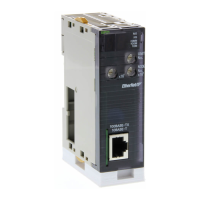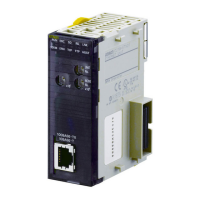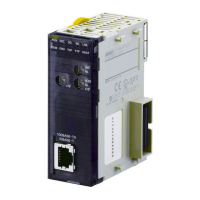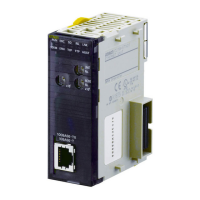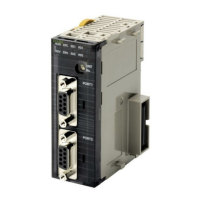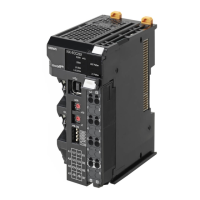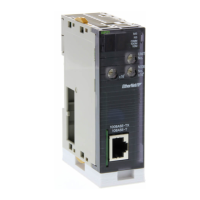
Do you have a question about the Omron CJ1W-EIP21 - 10-2010 and is the answer not in the manual?
| Brand | Omron |
|---|---|
| Model | CJ1W-EIP21 - 10-2010 |
| Category | Network Hardware |
| Language | English |
Defines the target personnel qualified to use this manual and product, requiring knowledge of electrical systems.
User must operate the product according to performance specifications and consult OMRON representative for unspecified conditions.
Crucial warnings about handling units with power supplied, touching terminals, and disassembling/repairing units.
Guidelines for operating the control system in various locations, avoiding direct sunlight, extreme temperatures, and dust.
Essential safety and operational advice for using EtherNet/IP Units, including grounding, power supply handling, and wiring.
Information on compliance with EMC Directives and Low Voltage Directive, and applicable standards.
Details the features of EtherNet/IP Units and built-in ports, including data exchange, FINS messaging, and network connections.
Lists essential devices like switching hubs and twisted-pair cables for configuring an EtherNet/IP system.
Describes essential software like CX-Programmer and Network Configurator for setting up EtherNet/IP networks.
Explains supported services like CIP (Tag Data Links) and FINS (TCP/UDP) for EtherNet/IP communication.
Details the Network Configurator software package for building, setting, and controlling multi-vendor EtherNet/IP networks.
Provides detailed specifications for EtherNet/IP Units and built-in ports across CS/CJ series and CJ2 CPU Units.
Explains the names and functions of various components and indicators on EtherNet/IP Units and built-in ports.
Recommends network devices and discusses switching hub types and functions for EtherNet/IP networks.
Outlines the step-by-step procedures for initial setup of EtherNet/IP Units and built-in ports.
Explains how to set the Unit Number and Node Address switches for CS-series and CJ-series units.
Provides instructions and precautions for mounting EtherNet/IP Units into CS-series and CJ-series PLC racks.
Covers basic installation precautions, recommended products, and cable laying practices for Ethernet systems.
Details Ethernet connectors and proper procedures for connecting twisted-pair cables to the network.
Explains the purpose of I/O tables and procedures for creating them using CX-Programmer or Programming Console.
Describes three methods for setting the local IP address for EtherNet/IP Units and built-in ports.
Details TCP/IP related settings like IP address and subnet mask, configurable via CX-Programmer.
Explains setting parameters for tag data links using the Network Configurator and its Datalink Tool.
Covers additional communication and operation parameters like FINS/UDP, FINS/TCP, FTP, Auto Adjust Time, SNMP.
Describes how to test communications using the PING command and verifies EtherNet/IP Unit operation.
Details the CPU Unit words allocated to EtherNet/IP Units and built-in ports for CIO, DM, and user settings areas.
Explains the data stored in allocated CIO Area words, including unit control bits and target node information.
Describes the allocated DM Area words, specifically the IP Address Display/Setting Area for configuring IP addresses.
Explains how user settings area can be used for registered target node info, operating status, and error info.
Covers read-only bits/words and read/write bits in the CPU Unit's Auxiliary Area related to EtherNet/IP Units.
Explains IP address configuration, classes (A, B, C), network numbers, host numbers, and allocation principles.
Details specifying nodes, allocating addresses, and pairing IP with FINS node addresses for FINS communication.
Differentiates between private (Intranet) and global (Internet) IP addresses and their usage.
Introduces tag data links for cyclic data exchange between PLCs and devices, covering features and operation.
Provides a comprehensive guide on setting up tag data links using the Network Configurator and its Datalink Tool.
Explains how to use status flags and programming logic to detect normal status and errors in tag data links.
Introduces message communications using FINS and explicit messages for command/response between nodes.
Explains how to exchange messages with FINS commands over Ethernet between nodes supporting FINS.
Describes sending service requests using CIP UCMM and explicit messages to other EtherNet/IP devices.
Details methods for obtaining information on communications errors by checking the error log or indicators.
Lists main errors occurring during message transmission and reception, with causes and countermeasures.
Introduces FINS communication services on Ethernet networks, covering UDP/IP and TCP/IP methods.
Details the FINS/UDP method, its features, frame format, and procedure for using it.
Explains the FINS/TCP method, its characteristics, frame format, port numbers, and connection numbers.
Describes the creation and usage of routing tables for FINS messages, including local and relay network tables.
Shows how to connect online using CX-Programmer and FinsGateway for FINS/UDP and FINS/TCP communications.
Provides guidance on avoiding errors due to heavy traffic in FINS communications by managing communication load.
Explains how to send explicit messages using CIP UCMM and EXPLICIT MESSAGE SEND commands.
Describes how EtherNet/IP Units receive explicit messages, supporting UCMM and Class 3 communications.
Details tag data link communication methods, packet interval (RPI) settings, and network transmission delay.
Explains how to check and adjust bandwidth usage, RPI, and device bandwidth for optimal network performance.
Covers timing of data transmissions, processing times, and calculation examples for I/O response time.
Explains maximum transmission delays for SEND/RECV/CMND instructions, excluding network delays.
Introduces the built-in FTP server function for EtherNet/IP Units, enabling file transfer via FTP client software.
Details file types, executable commands, protection settings, and protocol for the FTP server.
Provides procedures and settings required for using the FTP server, including login and file transfer.
Describes FTP commands for connecting, file management, and transferring files between host and remote devices.
Provides an overview of obtaining clock information from an SNTP server to refresh the local CPU Unit's clock.
Details the procedure and required settings for automatic clock adjustment using CX-Programmer and SNTP server.
Covers causes and remedies for SNTP errors and lists error log codes for the automatic clock adjustment function.
Describes routine cleaning, inspection, and procedures for replacing faulty EtherNet/IP Units or built-in ports.
Explains the simple backup function for backing up CPU Unit and EtherNet/IP Unit data to a Memory Card.
Details how to use the PLC Backup Tool from CX-Programmer for backing up, comparing, and restoring PLC data.
Describes using the Network Configurator's Device Monitor function to check device and connection status.
Explains how to interpret LED indicators and 7-segment display errors on EtherNet/IP Units for troubleshooting.
Details error codes and handling procedures based on tag data link connection status.
Explains the error log data specifications, registration, FINS commands, and error codes for error analysis.
Provides solutions for general Ethernet problems, CPU Unit indicators, tag data link failures, and message timeouts.
Details how to identify errors using SEND/RECV/CMND instruction response codes for EtherNet/IP Units.
Explains the basic concepts of CIP message communications, including Object Model, Class, Instance, Attribute, and Service.
Describes the EPATH type used to specify the route path for CIP message communications, including segments and formats.
Provides instructions for installing EDS files in the Network Configurator, recommending administrator privileges.
Explains the procedure to create EDS files for the Network Configurator, requiring device and I/O information.
Details the steps to delete EDS files from the Network Configurator's Hardware List.
Describes how to save EDS files to a specified folder and file name from the Network Configurator.
Explains how to search for devices (EDS files) within the Hardware List using character strings.
Shows how to display the properties of an EDS file, including creation time and device information.
Explains how to adjust Windows Firewall settings to enable EtherNet/IP connections for CX-Programmer or Network Configurator.
Provides examples for setting tag data links on CJ2M CPU Units based on unit version and data size.
Illustrates common incorrect tag data link settings that exceed maximum data size or node limits.
